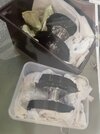I'll check the paint thickness when I have it apart later today or tomorrow, and I won't apply new paint where it doesn't belong.
I partially disassembled the rear hub yesterday, removing the brake plate and exposing the tapered bearing.
View attachment 46525
At this point the 10 H19/1 hub bolts also are revealed (only 5 are shown in the drawings, presumably for parts dating from an earlier age). I'm guessing that the portion of the bolts that fit in the brake hub are knurled in some way to keep them from turning when the nuts are attached. The next photograph shows how close these nuts are together, having evolved from the earlier 5-bolt pattern which would have given them a more generous spacing,
View attachment 46526
Based on the above, I don't see why there would be any particular problem fitting the spokes before tightening the flanges. That is, it doesn't appear there would be an advantage to having a sufficient gap between brake hubs and spoke flanges to insert the spokes after the flanges were tightened. Unless, of course, a spoke needed to be replaced in a wheel that was already laced. Comments?
On the other hand, apparently some people use a spacer (shown in red) to allow room to install and remove spokes.
View attachment 46528
However, the steps in the hollow axle noted with arrows provide hard stops for the bearings, and the brake plates provide hard stops at the other end. The H17 shims correct for production tolerances to give the desired end float. Unless the red spacer is thin enough that the correct end float can be achieved with no, or thin, shims, a red spacer is a bodge, not an option. Again, comments please.
Note that in the above drawing I've replaced what is shown in the Alternative Spares manual for the bearing and shims with what is in the Vincent spares manual. The inset below is from the Alternative manual, showing a "spacer" next to the bearing, which isn't shown in the Vincent manual, along with what are probably the K17 shims, although they aren't called out with part numbers.

